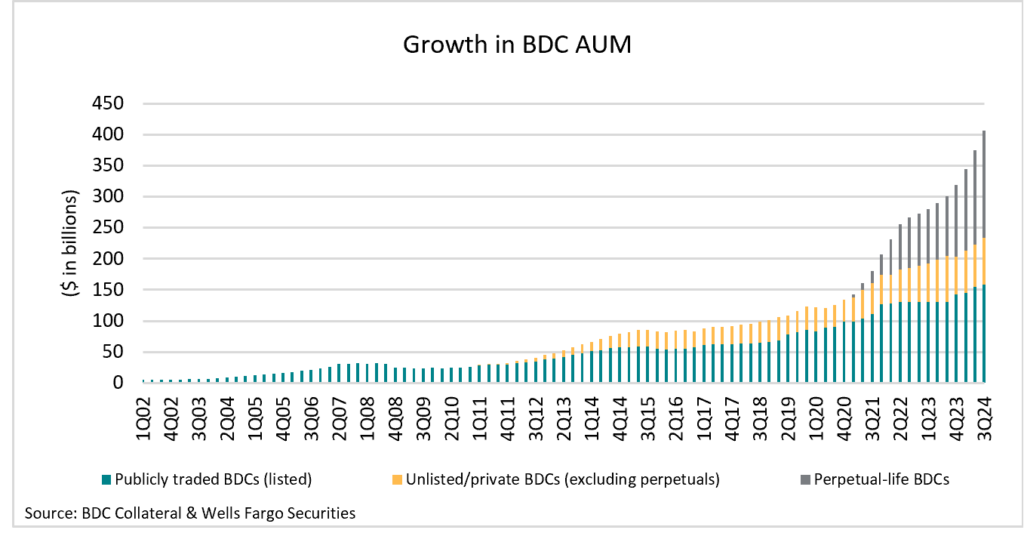December 17, 2024 - The BDC Quarterly Wrap highlights select data points to provide a readout on BDC growth, structure, financing and asset quality. For context, growth data includes the entire BDC universe, which consists of 159 funds; all other data captures BDCs reporting financials by December 2nd, representing a universe of 155 funds.

Market. In 3Q24, Business Development Companies’ (BDCs) assets under management (AUM) jumped 35% year-over-year and 9% consecutively to $407B, according to LSEG LPC’s BDC Collateral. The data is segmented into three cohorts: publicly traded BDCs, non-traded and private BDCs, and perpetual-life BDCs (i.e., non-traded BDCs with indefinite durations that offer shares continuously by recycling periodic share redemptions). The growth in 3Q was largely attributable to perpetual BDCs, which experienced an 80% YoY increase in AUM to $173.9B. This figure represents 35 funds, or 23% of the universe. The largest perpetual BDC, Blackstone Private Credit Fund, accounts for 37% of the perpetual BDC AUM. By comparison, excluding perpetuals, non-traded and private BDCs increased 2% YoY to $75.41B and publicly traded BDCs grew 21% to $157.9B.
Leverage. Fund-level leverage inched down to 0.91x across all BDCs in 3Q24 from 0.92x in 2Q24, but rose from 0.87x in 3Q23, according to BDC Collateral. For BDCs with more than $500M in total assets, leverage increased to 1.01x in 3Q24 from 0.97x on average in 2Q24 and 1.02x in 3Q23. Forty-four percent of all BDCs were levered above 1x in 3Q24 (up from 32% in 2Q24 and 39% in 3Q23). BDCs have issued $23.175B in unsecured debt year to date through December 10th, 2024, up 334% (from $5.34B) year-over-year amid favorable credit spreads, according to Truist Securities.
Composition. The share of BDC portfolios comprising first-lien loans increased to 85.1% in 3Q24 from 84% in 2Q24 from 79.5% in 3Q23, while the share of second-lien loans fell to 3.7% from 4.2% and 6.9%, respectively, based on BDC Collateral data. The share of equities decreased to 7.7%, from to 8.1% in 2Q24 and 9.6% in 3Q23.
Credit Risk. Net realized losses increased to $864M in 3Q24 from $518M in 2Q24 and $528M in 3Q23, BDC Collateral data shows. BDCs have reported net realized losses for the last nine quarters. The weighted average non-accrual rate for public and non-traded/private BDCs fell to 1.43% in 3Q24 from 1.7% in 2Q24 and 1.44% in 3Q23. Loans to borrowers in the healthcare, general manufacturing and services industries experienced the most non-accruals.
Weighted average payment-in-kind (PIK) interest as a percentage of BDC total investment income (for BDCs that reported PIK income) was 6.66% in 3Q24 compared to 6.63% in 2Q24 and 5.69% in 3Q23, according to BDC Collateral. We include PIK interest as part of credit risk analysis because it captures loans that may be experiencing stress (i.e., converted from cash interest to PIK interest via amendment). However, as we’ve noted previously, not all PIK interest stems from conversions: Loans to performing companies are often structured with PIK optionality or partial PIK at origination. In 3Q24, new PIK investments accounted for 6.53% of new investments in BDCs, up from 5.67% in 2Q24 and down from 6.73% in the same period a year ago according to SOLVE.

In its December 6th 3Q24 BDC Ratings Compendium, KBRA highlighted that BDCs (as represented by the universe of 29 BDCs that it rates) have increasingly incorporated PIK optionality in portfolios in 2024 in response to competitive pressures but that PIK remains a small percentage of BDC interest income. The ratings agency asserts that the majority of PIK loans originated by BDCs are not indicative of future non-accruals or a shift toward partial PIK but instead aim to accommodate high-growth companies in the stages of reinvesting in their businesses. To this point, technology investments, which often include recurring revenue (ARR) loans originated with PIK interest, currently represent 21% of BDC portfolios, according to BDC Collateral.






